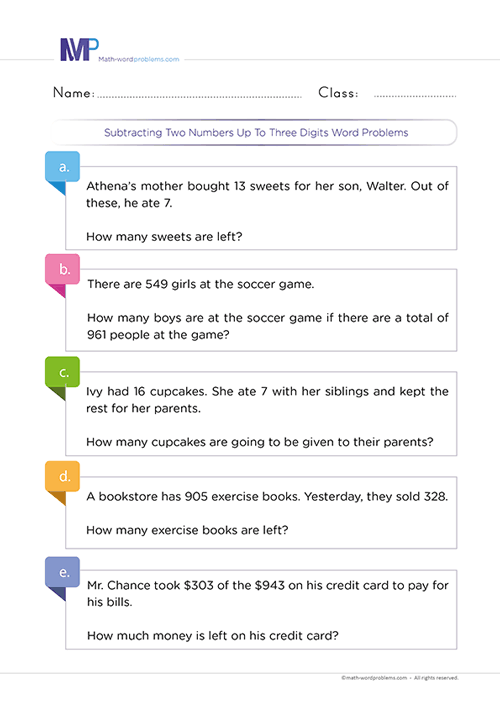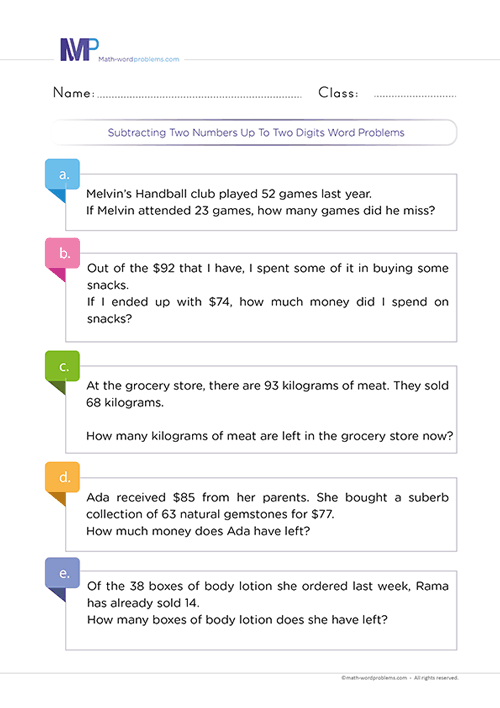 What is the best strategy to subtract two numbers up to three digits word problems?
What is the best strategy to subtract two numbers up to three digits word problems?

- INTRODUCTION
- Step 1 Identify
- Step 2 STRATEGIZE
- Step 3 SET UP
- Step 4 PROVIDE A SOLUTION
- Step 5 CHECK YOUR WORK
Get more contents on this skill...
Have you been asking yourself what is the best strategy to subtract two numbers up to three digits word problems? Then you are just at the right place because you will find unique and fun subtraction word problem-solving strategies that will motivate and inspire 3rd Graders to solve more subtraction problems anyway and at any time effectively.
We will equally include a unique step-by-step guide that adequately elaborates on the learners' ideal understanding and procedural knowledge before solving the problem.
Steps on subtracting two numbers up to three digits word problems
We have for your 3rd Graders here unprecedented steps on subtracting two numbers up to three digits word problems. We will systematically design these steps so that once kids go through them, they will gain the necessary skills for effective problem solutions. Once they become familiar with the best strategy to subtract two numbers up to three digits word problems, they will become successful problem solvers in all areas of math.
In addition, we will add a few real-life examples to show kids how exciting and easy these steps are.
Step 1 IDENTIFY THE PROBLEM
To identify the problem,
- Start by reading out the problem carefully to understand it.
- Then, identify and underline statements that are related.
- Now, reread the problem and try to figure out any important numbers and keywords in the problem.
Talking about keywords, if it is subtraction word problems, some of the keywords that you'll come across in the word problem are:- less, minus, take away, left, decrease, difference, remain, change, how many more, how much more, how many left, how many fewer, were left, subtract, fewer, deduct, remove, etc.
Note: learners should understand that it would be best not to rely entirely on keywords alone because a particular keyword can have different meanings in different word problems.
In that case, you need to read the question very well to understand the situation the word problem describes. After reading, you will also find out if the problem makes sense first before determining which operation you need to use.
Step 2 STRATEGIZE AND DETERMINE THE OPERATIONS
Now, ask yourself, "How will I solve this problem?"
Here, you must apply the read-to-understand rule. In this step, you have to read the word problem and try to interpret it in your own words.
In addition, since each word problem may require a different solving format, the key points below will enable you to tackle any word problem irrespective of the format.
- First, the keyword(s) in the word problem will help unravel the operation you need to carry out.
- But, relying on keywords alone to solve word problems has some limits, as mentioned in step 1 above.
- So with this in mind, you must first read the word problem to understand the scenario that the problem is describing.
- Understanding the problem's scenario will enable you to identify the problem type and relational statement, which, together with the keyword(s) in the problem, will determine the accurate math operation you need.
Step 3 SET UP A NUMBER SENTENCE AND AN EQUATION
- After knowing which operation you will perform from step 2 above, construct short sentences to represent the information given in the word problem.
- These short sentences represent the vital information that makes it easier to solve the word problem. In order words, it is like a diagram of the word problem.
- After that, deuce a solvable maths equation to represent the information in the sentences you constructed above.
Step 4 SOLVE THE PROBLEM
Next, after writing down the maths equation, solve the problem using any subtraction method of your choice, preferably the column method. Besides this, don't forget to include the unit of measurement in your final answer.
Step 5 VERIFY YOUR ANSWER
Finally, check your work to make sure that your answer is correct. For instance, since you are dealing with only numbers and not algebraic expressions, it is good to use reasonableness by estimation to see if your answer makes sense.
Therefore, if you estimate and the answer is close to what you have, your answer is correct. However, if your answer is beyond reasonable limits, you must go back to step one and start again.
Examples of how to subtract two numbers up to three digits word problems
Example One
Step 1: Read the problem and underline all the relational statements. Then the important numbers that you will find after reading the problem are $236 and $918. Also, the keyword you will find in the word problem is "left."
Step 2:Now, how are you going to solve this problem?
The problem is that Mr. Adam had a certain amount of money on his credit card but removed a certain amount less than the one he had on the credit card to pay his bills.
So, the problem wants you to find the amount left from that money he initially had on his credit card.
With this problem scenario in mind, you should ask yourself: "which operation can I use to find out what is remaining after removing and using a certain amount of money from my credit card?"
So you see that, from the situation that the problem is describing, from retelling the problem in your own words and from the keyword "left" found in the word problem calls for you to perform a subtraction operation.
Step 3: Construct short sentences representing the most vital information in the word problem.
Also, write down a solvable maths equation representing the information given in the sentence that is in bold below.
- Amount of money he has on his credit card = $918
- Amount of money he took out of the credit card to pay his bills = $236
- Therefore, the amount of money left on his credit card = the amount he had on his credit card - the amount he took out of the credit card to pay his bills.
→ $918 - $236 =?
Step 4: From step 3 above, stack the values in the equation you formed so that their place values should line up. You can solve the problem using any subtraction method, preferably the column method. Besides this, don't forget to include the unit of measurement in your final answer.
So, he has $682 left on his credit card
Step 5:Finally, check your work to ensure your answer is correct. Since you are dealing with only numbers and not algebraic expressions, it is good to use reasonableness by estimation to see if your answer makes sense.
So, if you estimate and the answer is close to the one you have, then your answer is correct. However, if your answer is beyond reasonable limits, you must go back to step one and start again.
Example Two
Step 1: First, read the problem and underline all the relational statements. You see that the important numbers you will find after reading the problem are 941 and 372. Also, the keyword you will find in the word problem is "how many."
Step 2: The question is, how will you solve this problem?
You see that the keyword alone cannot determine which operation you need to use.
First, read and retell the problem in your own words to come out with the correct operation without necessarily depending on the keyword.
The problem is that out of a certain number of pupils in a school, a given number are boys, and the rest are girls.
So, the problem wants you to find the number of girls.
When you get the answer to this question, you now proceed to the next question
Now, the question that you should be asking yourself is: - "which operation can I use to find a certain number of pupils that, if I join with the given number of pupils, will give me the exact total number of pupils?"
You see that, from the situation that the problem is describing, from retelling the problem in your own words, and from the keyword "how many" found in the word, it shows that we need to carry out a subtraction operation.
Step 3: Construct short sentences representing the most vital information in the word problem.
Also, write down a solvable maths equation representing the information given in the sentence that is in bold below.
- Total number of pupils = 941
- Number of boys = 372
- Therefore, the number of girls in the school = the total number of pupils - the number of boys.
→ 941 – 372 = ?
Step 4: From step 3 above, stack the values in the equation you formed so that their place values should line up. Then, go ahead and subtract the values using any method of subtraction, preferably the column method. Also, it would be best if you remember always to include the unit of measurement in the final result.
So, 569 pupils are girls
Step 5: Finally, check your work to ensure your answer is correct. Since you are dealing with only numbers and not algebraic expressions, it is good to use reasonableness by estimation to see if your answer makes sense.
So, if you estimate and the answer is close to the one you have, then your answer is correct. However, if your answer is beyond reasonable limits, you must go back to step one and start again.




